tow bar DACIA LODGY 2020 Owners Manual
[x] Cancel search | Manufacturer: DACIA, Model Year: 2020, Model line: LODGY, Model: DACIA LODGY 2020Pages: 220, PDF Size: 2.62 MB
Page 133 of 220
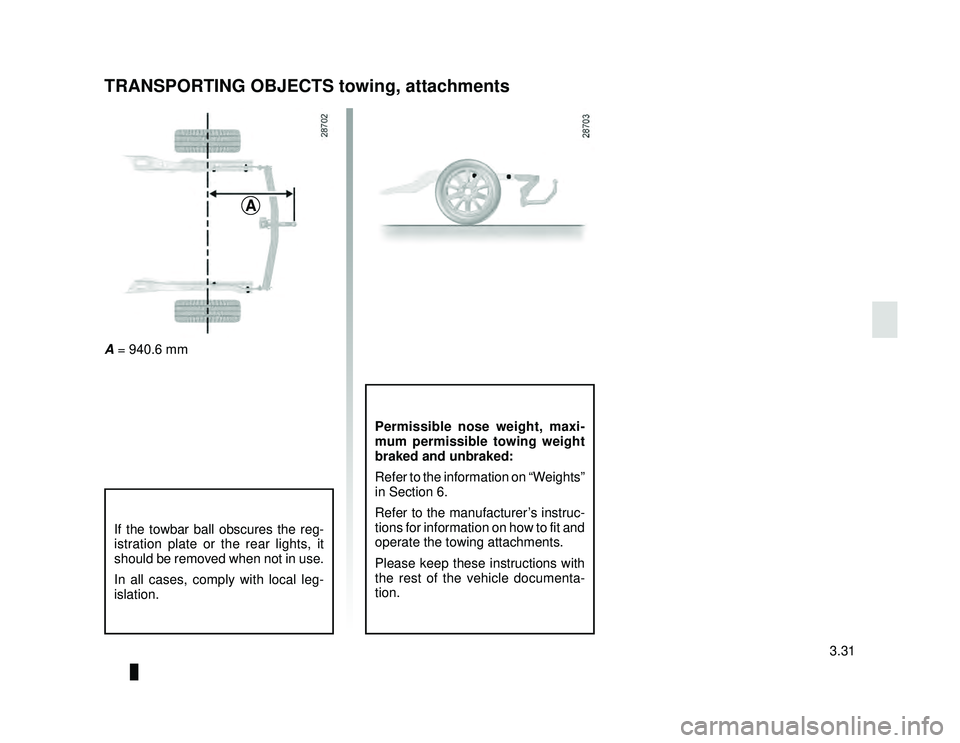
JauneNoir Noir texte
3.31
ENG_UD29926_3
Remorquage: attelage (X92 - Renault)
ENG_NU_975-6_X92_Dacia_3
TRANSPORTING OBJECTS towing, attachments
Permissible nose weight, maxi-
mum permissible towing weight
braked and unbraked:
Refer to the information on “Weights”
in Section 6.
Refer to the manufacturer’s instruc-
tions for information on how to fit and
operate the towing attachments.
Please keep these instructions with
the rest of the vehicle documenta-
tion.
A
A = 940.6 mm
If the towbar ball obscures the reg-
istration plate or the rear lights, it
should be removed when not in use.
In all cases, comply with local leg-
islation.
Page 147 of 220
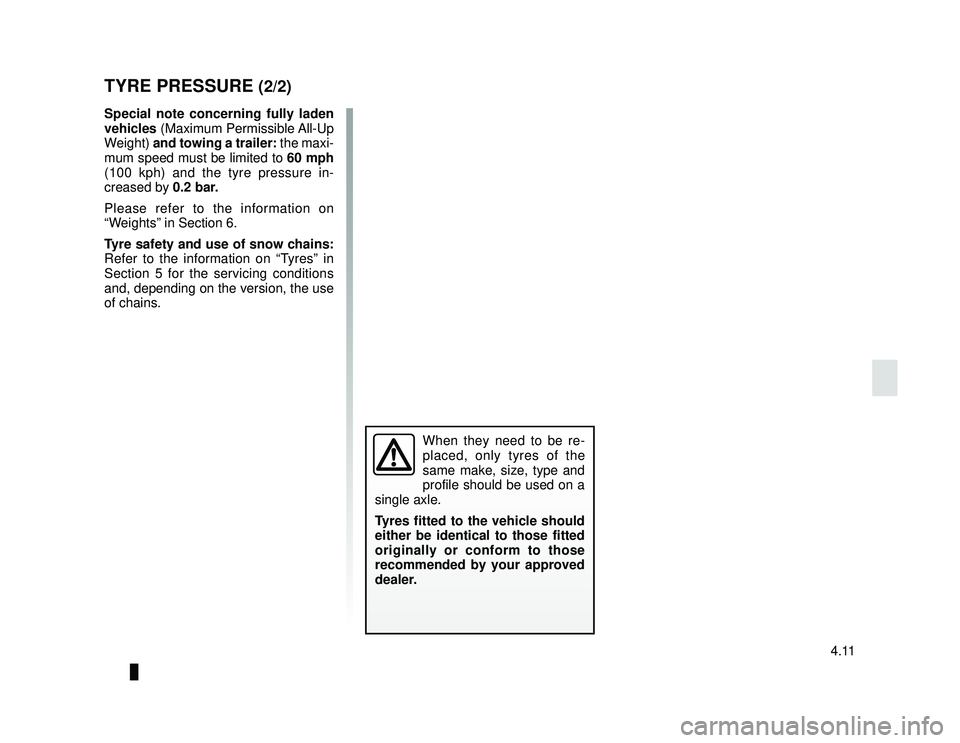
JauneNoir Noir texte
4.11
ENG_UD28917_3
Pressions de gonflage des pneumatiques à froid (X92 - Renault)
ENG_NU_975-6_X92_Dacia_4
When they need to be re-
placed, only tyres of the
same make, size, type and
profile should be used on a
single axle.
Tyres fitted to the vehicle should
either be identical to those fitted
originally or conform to those
recommended by your approved
dealer.
TYRE PRESSURE (2/2)
Special note concerning fully laden
vehicles (Maximum Permissible All-Up
Weight) and towing a trailer: the maxi-
mum speed must be limited to 60 mph
(100 kph) and the tyre pressure in-
creased by 0.2 bar.
Please refer to the information on
“Weights” in Section 6.
Tyre safety and use of snow chains:
Refer to the information on “Tyres” in
Section 5 for the servicing conditions
and, depending on the version, the use
of chains.
Page 185 of 220
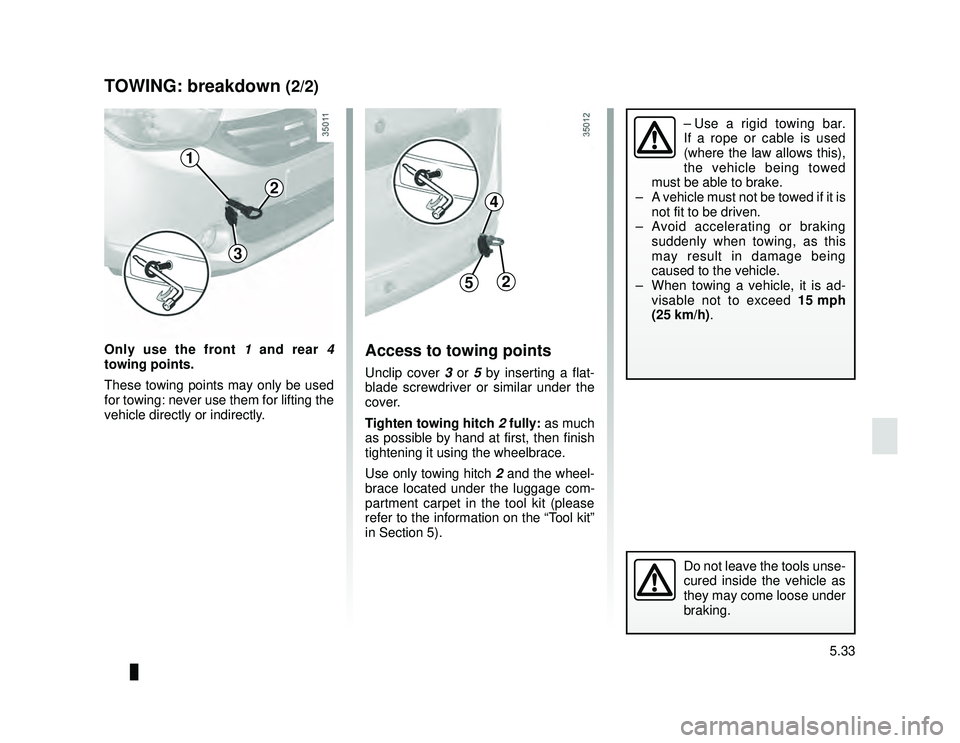
JauneNoir Noir texte
5.33
ENG_UD24482_1
Remorquage: dépannage (X92 - Renault)
ENG_NU_975-6_X92_Dacia_5
Only use the front 1 and rear 4
towing points.
These towing points may only be used
for towing: never use them for lifting the
vehicle directly or indirectly.Access to towing points
Unclip cover 3 or 5 by inserting a flat-
blade screwdriver or similar under the
cover.
Tighten towing hitch 2 fully: as much
as possible by hand at first, then finish
tightening it using the wheelbrace.
Use only towing hitch 2 and the wheel-
brace located under the luggage com-
partment carpet in the tool kit (please
refer to the information on the “Tool kit”
in Section 5).
– Use a rigid towing bar.
If a rope or cable is used
(where the law allows this),
the vehicle being towed
must be able to brake.
– A vehicle must not be towed if it is not fit to be driven.
– Avoid accelerating or braking suddenly when towing, as this
may result in damage being
caused to the vehicle.
– When towing a vehicle, it is ad- visable not to exceed 15 mph
(25 km/h).
Do not leave the tools unse-
cured inside the vehicle as
they may come loose under
braking.
TOWING: breakdown (2/2)
1
4
3
5
2
2
Page 198 of 220
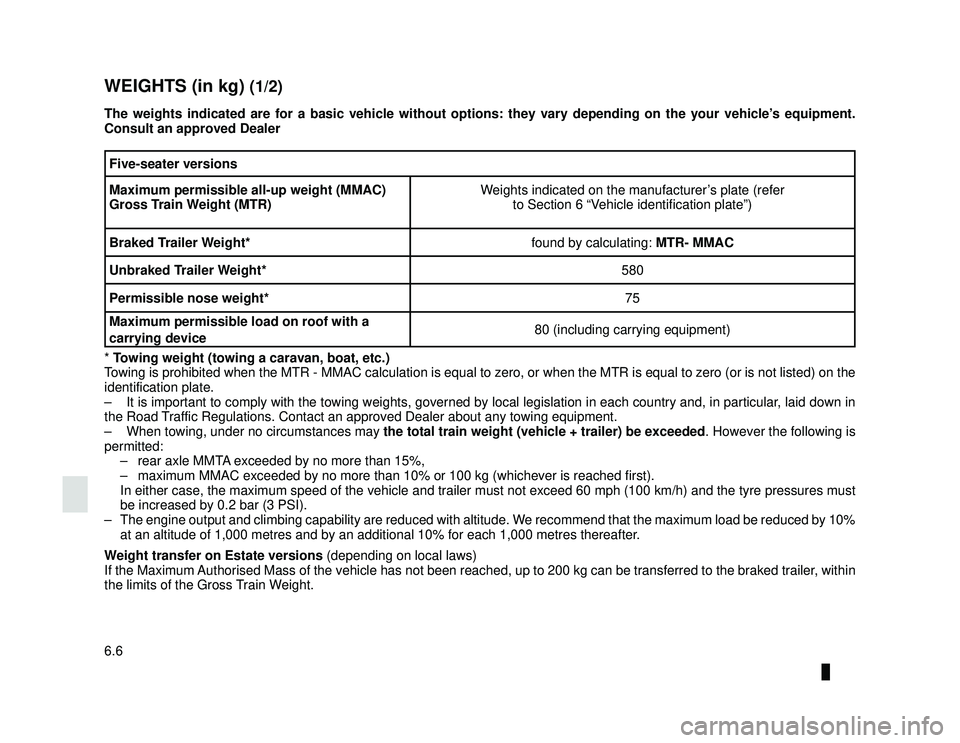
JauneNoir Noir texte
6.6
ENG_UD33477_4
Masses (en kg) (X92 - Renault)
ENG_NU_975-6_X92_Dacia_6
WEIGHTS (in kg) (1/2)
The weights indicated are for a basic vehicle without options: they vary\
depending on the your vehicle’s equipment.
Consult an approved Dealer
Five-seater versions
Maximum permissible all-up weight (MMAC)
Gross Train Weight (MTR) Weights indicated on the manufacturer’s plate (refer
to Section 6 “Vehicle identification plate”)
Braked Trailer Weight* found by calculating: MTR- MMAC
Unbraked Trailer Weight* 580
Permissible nose weight* 75
Maximum permissible load on roof with a
carrying device 80 (including carrying equipment)
* Towing weight (towing a caravan, boat, etc.)
Towing is prohibited when the MTR - MMAC calculation is equal to zero, or\
when the MTR is equal to zero (or is not listed) on t he
identification plate.
– It is important to comply with the towing weights, governed by local leg\
islation in each country and, in particular, laid down in
the Road Traffic Regulations. Contact an approved Dealer about any towing equipment.
– When towing, under no circumstances may the total train weight (vehicle + trailer) be exceeded . However the following is
permitted: – rear axle MMTA exceeded by no more than 15%,
– maximum MMAC exceeded by no more than 10% or 100 kg (whichever is reach\
ed first).
In either case, the maximum speed of the vehicle and trailer must not ex\
ceed 60 mph (100 km/h) and the tyre pressures must be increased by 0.2 bar (3 PSI).
– The engine output and climbing capability are reduced with altitude. We recommend that the maximum load be reduced by 10% at an altitude of 1,000 metres and by an additional 10% for each 1,000 m\
etres thereafter.
Weight transfer on Estate versions (depending on local laws)
If the Maximum Authorised Mass of the vehicle has not been reached, up to 200 kg can be transferred to the braked trailer, with in
the limits of the Gross Train Weight.
Page 199 of 220
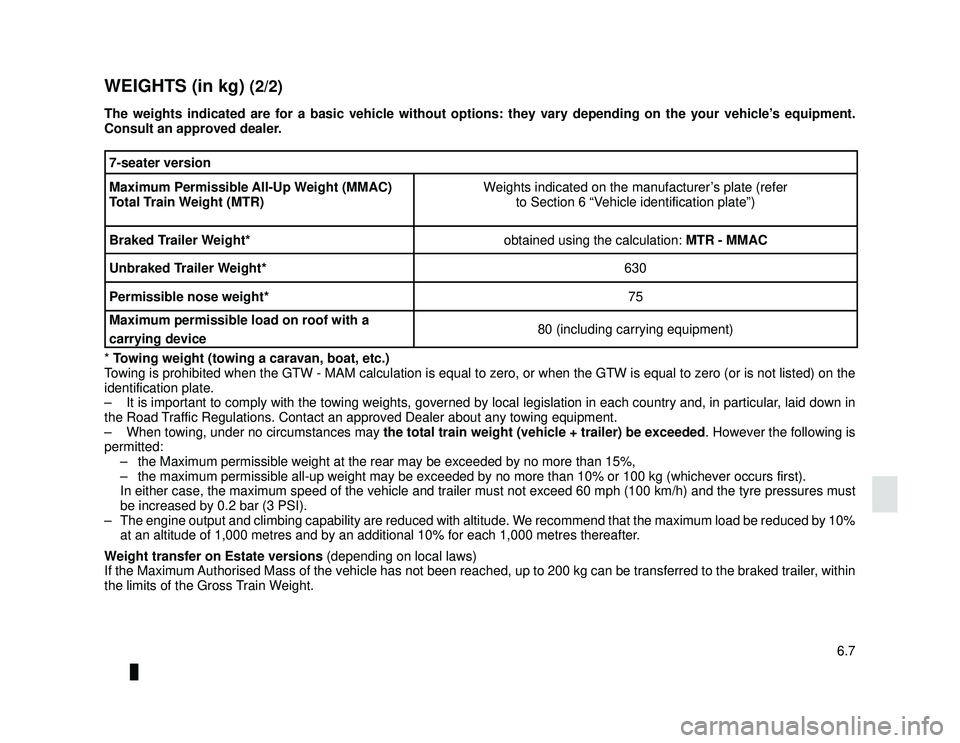
JauneNoir Noir texte
6.7
ENG_UD33477_4
Masses (en kg) (X92 - Renault)
ENG_NU_975-6_X92_Dacia_6
WEIGHTS (in kg) (2/2)
The weights indicated are for a basic vehicle without options: they vary\
depending on the your vehicle’s equipment.
Consult an approved dealer.
7-seater version
Maximum Permissible All-Up Weight (MMAC)
Total Train Weight (MTR) Weights indicated on the manufacturer’s plate (refer
to Section 6 “Vehicle identification plate”)
Braked Trailer Weight* obtained using the calculation: MTR - MMAC
Unbraked Trailer Weight* 630
Permissible nose weight* 75
Maximum permissible load on roof with a
carrying device 80 (including carrying equipment)
* Towing weight (towing a caravan, boat, etc.)
Towing is prohibited when the GTW - MAM calculation is equal to zero, or \
when the GTW is equal to zero (or is not listed) on th e
identification plate.
– It is important to comply with the towing weights, governed by local leg\
islation in each country and, in particular, laid down in
the Road Traffic Regulations. Contact an approved Dealer about any towing equipment.
– When towing, under no circumstances may the total train weight (vehicle + trailer) be exceeded . However the following is
permitted: – the Maximum permissible weight at the rear may be exceeded by no more th\
an 15%,
– the maximum permissible all-up weight may be exceeded by no more than 10\
% or 100 kg (whichever occurs first).
In either case, the maximum speed of the vehicle and trailer must not ex\
ceed 60 mph (100 km/h) and the tyre pressures must be increased by 0.2 bar (3 PSI).
– The engine output and climbing capability are reduced with altitude. We recommend that the maximum load be reduced by 10% at an altitude of 1,000 metres and by an additional 10% for each 1,000 m\
etres thereafter.
Weight transfer on Estate versions (depending on local laws)
If the Maximum Authorised Mass of the vehicle has not been reached, up to 200 kg can be transferred to the braked trailer, with in
the limits of the Gross Train Weight.